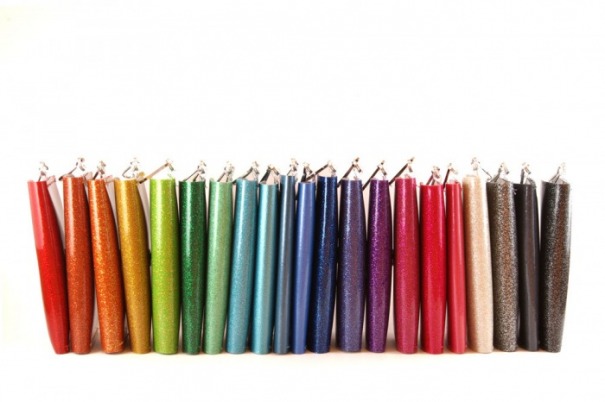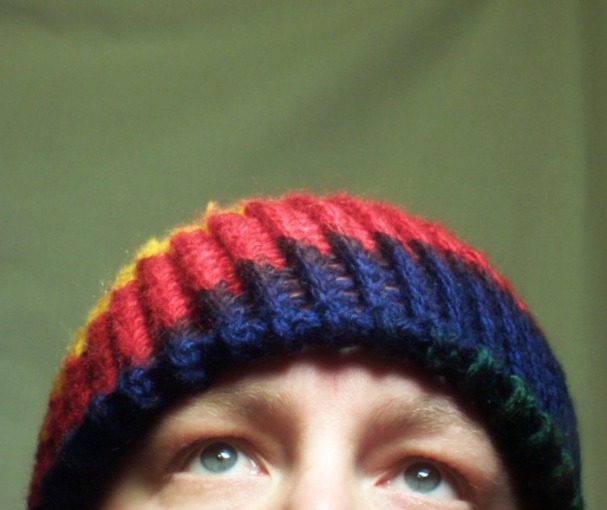:091122: Though my cell is drab and grey upon first glance, closer inspection reveals magnificent colors everywhere.
Color is perceived by sensitive light receptors in the eyes of humans. Different types of these receptors, called cones, have differing sensitivity to a variety of wavelengths of light. These differences may even vary from human to human. My green may not be your green. No, it's OK. I'm quite fond of my green.
The human eye also contains rods, which are even more sensitive to light, but not to color. At low light levels, the cones cease to function, but the rods still work. This is why when you wake up in the middle of the night, you can see objects in your bedroom well enough, but the whole scene is in black-and-white. Never thought about it that way? Try it. It's eerie.
So, those rods are pretty amazing, but color vision is spectacular. The human brain distinguishes color by differentiating between responses to different wavelengths of light. Technically, this refers to physical responses in the photoreceptors in the eye itself, but think about how the human brain must distinguish between emotional responses, as well. There are colors that make me feel warm and happy. There are colors that make me feel relaxed. There are colors that make me uncomfortable. The emotional distinction reinforces the visual distinction in my brain, and it has done so all my life.
But what happens when more than one color is present in my field of vision? Do I feel warm, happy, relaxed, AND uncomfortable all at the same time? Not really. In fact, with all the colors represented harmoniously, I feel just that: harmonious. Something is right with the world when the full spectrum of visible light is represented.
This happens naturally on this planet, in the form of a rainbow. Though the colors in a natural rainbow may be perceived as distinct bands of color, a rainbow is actually a continuous spectrum. The human eye, and by extension, the human brain, distinguishes the separate colors because it is easier to think about them that way. The human brain cannot truly comprehend the infinite.
Rainbows are caused by the colors present in white light refracting through tiny droplets of water, and can occur wherever one finds rain, mist, spray and dew. Dew, is of course one of my favorite places to find rainbows...
The human eye also contains rods, which are even more sensitive to light, but not to color. At low light levels, the cones cease to function, but the rods still work. This is why when you wake up in the middle of the night, you can see objects in your bedroom well enough, but the whole scene is in black-and-white. Never thought about it that way? Try it. It's eerie.
So, those rods are pretty amazing, but color vision is spectacular. The human brain distinguishes color by differentiating between responses to different wavelengths of light. Technically, this refers to physical responses in the photoreceptors in the eye itself, but think about how the human brain must distinguish between emotional responses, as well. There are colors that make me feel warm and happy. There are colors that make me feel relaxed. There are colors that make me uncomfortable. The emotional distinction reinforces the visual distinction in my brain, and it has done so all my life.
But what happens when more than one color is present in my field of vision? Do I feel warm, happy, relaxed, AND uncomfortable all at the same time? Not really. In fact, with all the colors represented harmoniously, I feel just that: harmonious. Something is right with the world when the full spectrum of visible light is represented.
This happens naturally on this planet, in the form of a rainbow. Though the colors in a natural rainbow may be perceived as distinct bands of color, a rainbow is actually a continuous spectrum. The human eye, and by extension, the human brain, distinguishes the separate colors because it is easier to think about them that way. The human brain cannot truly comprehend the infinite.
Rainbows are caused by the colors present in white light refracting through tiny droplets of water, and can occur wherever one finds rain, mist, spray and dew. Dew, is of course one of my favorite places to find rainbows...




 RSS Feed
RSS Feed
